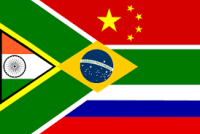Argentina in BRICS: Consequences and Prospects of Membership
Can LatAm’s second largest economy make an impact on global trade via BRICS? Bueno Aries hopes so, but the decision hangs on October’s national elections.
By Farzad Ramezani Bonesh
Argentina’s membership process in BRICS
The increase in attractiveness and the economic position of BRICS with about 26% of the area and about 42% of the world’s population and strengthening of the economic and financial cooperation of BRICS has caused Buenos Aires to be eager to join the group.
The possibility of Argentina joining the BRICS group started a decade ago. Previously, Argentina participated in the BRICS meetings in 2014 and 2018. In the past years, with Xi Jinping’s invitation to Alberto Fernandez, at the 2022 meeting, the trip to Russia and China, and consultations with India, the idea of Argentina to officially join BRICS was revived with the support of Brazil.
Buenos Aires requested full membership in the group in June 20223 during negotiations with BRICS representatives. Buenos Aires’ extensive relations with BRICS members made them support Argentina’s efforts to join the bloc. The 15th BRICS summit decided to invite Argentina to become a full BRICS member from January 1, 2024.
Consequences and opportunities of BRICS membership for Argentina
In the case of the continuation of the ruling party’s ruling, Argentina will be considered an official BRICS member from January 2024. The president of Argentina also considers it an important step, and a great opportunity to strengthen Argentina’s economy, and a great opportunity that should not be wasted.
From this point of view, the possibility of joining new markets, consolidating existing markets, increasing investment, creating jobs, and increasing imports will increase. From the point of view of Buenos Aires, BRICS has an increasing role in the future of the global economy and geopolitics.
While the world is changing fast, it seems that Fernández wants to use BRICS membership as a lever to pay more attention to multilateralism, promote peaceful resolution of disputes, and more support for Argentina’s sovereignty.
Argentina is the eighth largest country in the world with an area of 2,780,400 square kilometers and a population of 44 million people. Argentina’s economy, with a gross domestic product (GDP) of about US$1.275 trillion (PPP) is the second largest economy in LatAm, however, has become embroiled in an economic crisis. Internal and external factors such as foreign debt and capital flight are important factors in the crisis in Argentina.
In a critical situation including annual inflation over 100%, foreign borrowing, capital flight, currency shortage, and the rise of the rating of economic risk, destructive drought, and foreign debt of more than US$270 billion, BRICS can help to solve some challenges.
With BRICS membership, Argentina wants to promote economic growth, diversify the economy, develop e-commerce, and market integration, and have access to cooperation with other BRICS countries.
The government is also looking at opening new markets, consolidating existing markets, supporting investment flows, creating jobs, increasing exports, and using better technologies with BRICS. In 2022, the International Monetary Fund (IMF) approved a US$44 billion loan to Argentina. However, while, foreign loans are usually inefficient, the country’s economy has become dollar-oriented, net reserves are nearly negative and the due date of the debts has arrived.
BRICS members with trillions of dollars in reserves and plenty of liquidity can help Argentina. Inflation in August was the highest monthly rate in 32 years, and some blame the International Monetary Fund.
From the point of view of the proponents of joining BRICS, it is an opportunity to find alternative sources of finance, such as the new development bank (or BRICS bank), certainly reduce dependence on the dollar, (keeping the Argentinian Peso weak is in the interests of US trade) and receiving BRICS bank loans with “different criteria”. In other words, the approach of the BRICS New Development Bank could lead to financial and technical assistance in Argentina and the granting of soft loans – including in local currency without the harsher conditions usually imposed by the IMF.
BRICS can also be an important card in negotiations with Western institutions and make difficult conditions easier for Buenos Aires. While considering Argentina’s foreign exchange problems, the BRICS approach in reforming the international financial system, forming alternative payment systems, a non-dollar financial system, increasing trade with domestic currencies, and creating a common currency can benefit Argentina.
From this point of view, the role of the New Development Bank can help towards the effective production and financing system for sustainable development, promoting more infrastructure projects and expanding the productivity and export capacity of the country. Also, for Buenos Aires, mutual respect, economic integration, and technology transfer are also more accessible with cooperation within BRICS.
Argentina has high potential in valuable mineral reserves, estimated at being worth up to US$4 trillion. But these commodities are mostly exported raw without any processing. Argentina is the third largest producer of lithium, the ninth producer of copper, the fourteenth producer of gold, and possesses 10.5% of global shale gas resources. With the help of BRICS members, it is expected that mineral export income will reach US$10 billion per annum.
Argentina is also an agricultural giant, especially in grain production and exports (reaching markets of 450 million people). The country is the world’s third largest producer of soybeans, the sixth largest producer of wheat, third largest of sunflower seeds, plus significant production of corn, peanuts, vegetables, and garden oils such as fruits and vegetables, and beef.
More than 75% of these products are produced for export, and an important part of Argentina’s agricultural exports already goes to the BRICS. Cooperation of strategic goods with new investments by BRICS sets a higher position for Argentina.
BRICS is seen by many as a valuable tool to increase exports in new markets, and Argentina’s entry into this bloc will promote productive development, jobs, and prosperity. Also, membership in BRICS can be a step to benefit from the experiences of member countries, develop trade, sign new trade agreements, and be a potential source of foreign direct investment (FDI) in Argentina.

Argentina’s bilateral trade with major BRICS members
A large part of Argentina’s trade is already with BRICS countries.
Argentina-Brazil

Diplomatic relations between the two countries took place on June 25, 1823. With geographical proximity and common borders, an industrialization model, ease of logistics, and benefits granted by MERCOSUR since 1991, Brazil has become the main trading partner of Argentina.
Brazil and Argentina recently formalized the adoption of a joint development action plan with 100 projects, in celebration of 200 years of diplomatic relations between the two countries.
The creation of a financing line, the expansion of the gas pipeline, the need to find solutions to expand financial integration and facilitate trade, the adoption of a specific reference currency for regional trade, close cooperation in strategic sectors such as nuclear energy, and Brazil’s assistance to Argentina’s negotiations with the International Monetary Fund (IMF) are important to deal with the economic crisis.
Brazil is Argentina’s largest trading partner and the main destination for Argentina’s exports. Nearly 20% of Argentina’s total imports come from Brazil. In 2022, the bilateral trade between the two countries was US$28.4 billion, with Brazilian exports being US15.3 billion, and imports about US$13.1 billion. Argentina is Brazil’s third-largest trading partner.
Brazilian goods imports in H1 2023 were US$9.573 million (51.1% of them were intermediate goods, 20% parts and accessories for capital goods, 8.9% capital goods, 8.7% passenger motor vehicles, 7.2% consumer goods, and 4.1% was fuel and lubricants). In trade relations, Brazil’s soy exports to Argentina are on the list of Brazil’s exports, even surpassing the automotive sector.
Argentina-Russia

Different Argentinian governments have had close relations with Russia for more than a decade. The 2008 agreement to establish strategic partnership relations, intensification of political and diplomatic contacts, visits between senior leaders, signing of about 20 agreements in 2014, and signing of agreements for joint exploration and production of uranium in 2018, has led to the expansion of relationships.
In fact, bilateral and multilateral interaction in almost all possible formats of relations covers a wide range of priority areas of interstate economic and political interactions. From the point of view of Buenos Aires, Argentina should be a “gateway for Russia to Latin America” and a reliable food supplier for the Russians under the imposed Western embargos.
Argentina, with a comprehensive strategic partnership with Russia, has paid attention to strengthening bilateral trade and Russian investment in Argentina, especially in infrastructure, energy and technological development, agriculture, and industry, trade and investment, cooperation in the fields of energy, space, nuclear energy, and multilateral cooperation of Mercosur and the Eurasian Economic Union (EAEU).
Bilateral trade with Russia reached US$1.33 billion in 2021, with Argentina’s exports at roughly half at US$679.98 million. However, financial and banking sanctions against Russia have brought problems to this trade. Argentina’s bilateral trade with Russia in 2022 was US$777.56 million, a 42% decrease compared to 2021 and problematic for Argentina’s import and exports. This is one reason why the global community has tended not to side with the West over Russian sanctions as it has damaged their own economies as well. However, work is being carried out by both sides to work out how to increase trade, with use of the RMB Yuan between them being discussed.
Lemons, oranges, pears, apples, peanuts, prunes, meat, dairy products, ocean fish, and king shrimp were among the main export products of Argentina to Russia. Argentina traditionally imported phosphate fertilizers and diesel from Russia.
Argentina-India

India and Argentina established diplomatic relations in 1948. India-Argentina relations were elevated to the level of strategic partnership during the official visit of the President of Argentina to India in February 2019. Relations have strengthened over the years and include political, economic, cultural, scientific, and technological cooperation.
Various bilateral dialogue mechanisms, the India-Argentina Joint Trade Committee (JTC), India-Argentina Business Council (IABC), and regular exchange of visits and interactions have boosted trade.
Several Indian companies are operating in Argentina with an investment of more than US$1 billion. Argentina’s investment in India is about US$120 million. Agreements to promote cooperation in the oil and energy sector and a trade agreement in the defense sector were signed in 2023.
India and Argentina hope that with common views on international issues, the India-Mercosur https://www.india-briefing.com/news/developing-global-free-trade-linking-india-mercosur-eurasian-economic-union-19261.html/ trade agreement, negotiations on the use of local currencies, convergence in the energy sector, and cooperation in the nuclear field, to expand the trade agreement and reach the trade volume to US$25 billion.
India is Argentina’s fourth largest trading partner. In 2021, India exported US$1.31 billion to Argentina, while Argentina exported US$4.19 billion to India. The India-Argentina bilateral trade registered a historic peak of US$6.4 billion in 2022, with a growth rate of 12% over 2021, with US$ 1.84 billion worth of exports from India to Argentina (31% growth rate) and US$4.55 billion worth of imports by India from Argentina.
India’s major exports to Argentina include petroleum oils, agrochemicals, manufactured textile yarn, oleic chemicals, drugs, and bicycles. India’s main import items from Argentina include metals, animals, coins, wood, and articles of wood, vegetable oils (soybean and sunflower), leather, grains, chemical residues.
Argentina-China

China’s contemporary trade relations with Argentina essentially began more than fifty years ago. In 2003, China started an unprecedented relationship in Argentina’s trade relations, and in 2004, they signed a strategic cooperation agreement.
Since 2010, cooperation has strengthened, with China becoming a key player in foreign direct investment and financing in agriculture, food, banking, communications, mining, and lithium. Nuclear power plant projects, dams, pork agreement, purchase of JF-17 fighter jets, activation of the bilateral treaty to eliminate double taxation, and a US$7.2 billion currency swap deal are all strong signs of cooperation.
China is a major source of foreign direct investment and lending in energy and infrastructure, including the massive Belt & Road Initiative. In early 2023, the total of Chinese investment in Argentina is estimated at US$40 billion.
China’s role in Argentina’s port, mining, energy, and railway infrastructure plan, a structured investment plan of about US$100 billion in the coming years, is important. China is the second largest destination for Argentina’s exports. Argentina has decided to strengthen its relations with China by joining the Beijing headquartered Asian Infrastructure Investment Bank, China’s Belt & Road Initiative, reactivating bilateral dialogue mechanisms, and holding meetings between their Presidents.
Argentina’s President visited Beijing in February 2022, endorsed the Belt & Road Initiative, after some pushback from Washington, and signed major projects worth more than US$23 billion.
Shortly after Argentina joined the BRI, a cooperation plan was signed between the two countries, covering 13 areas of strategic cooperation, including education, tourism, sports, science and technology, and defense.
However, Chinese investments are not progressing rapidly. But with highly complementary economies and South-South cooperation, port and maritime trade and transport thrive. Argentina also pioneered the use of the RMB Yuan as a swap mechanism for trade.
In 2021, China exported US$12.6 billion of goods to Argentina. In 2021, Argentina exported US$5.93 billion to China. In 2022, the value of products imported by Argentina from this Asian country reached more than US$17.5 billion, whereas exports amounted to nearly US$8 billion.
More recently, in June 2023, China exported US$1.17 billion and imported US$413 million from Argentina. The top exports of China to Argentina were telephones, other organic compounds, Nitrogen Heterocyclic Compounds, Computers, motorcycles, and cycles. In June 2023 the top imports of China from Argentina were Frozen Bovine Meat, Sorghum, Soybeans , Soybean Oil, and Raw Tobacco.
Argentina -South Africa

Apart from initial contacts in 1902 and diplomatic relations in 1947, full diplomatic relations between South Africa and Argentina were resumed in August 1991. Bilateral relations with a large number of visits, joint commissions, various common aspirations, and goals of the two governments provide a potential basis for relations.
Several agreements such as the development and mutual support of investment, air services, scientific and technological cooperation, the use of nuclear energy and agriculture, South-South cooperation, the signing of the Mercosur preferential trade agreement and the South African Customs Union (SACU), and Argentina’s new plan for Cooperation with Africa help business relations.
In 2021, Argentina exported US$442 million to South Africa, while South Africa exported US$223 million to Argentina. South African imports from Argentina reached US$461.12 million in 2022. Major Imports include, Cereals, Residues, wastes of the food industry, animal fodder, animal, and vegetable fats and oils, cleavage products, Vehicles other than railway, tramway, and meat.
Major exports include vehicles other than railways, tramways, Residues, and wastes of the food industry.
Argentina’s BRICS Vision

Although the president of Argentina assures that integration into the BRICS will occur, it is not clear what will happen to Argentina- BRICS relations.
In fact, Argentina’s future membership in BRICS will be determined by the national elections in October this year. However, Argentina’s opposition party rejects the BRICS concept. That said, an election victory by the Juntos por el Cambio coalition, current favorites to win, would probably not lead to the complete severing of relations with BRICS. How this pans out remains to be seen.
Despite some flaws in BRICS, the multi-dimensional potential of BRICS members can be positive for reducing the crisis of Argentina’s economy. In fact, if Argentina’s full and future membership in BRICS continues, it can have a positive impact on foreign direct investment, reaching the goals, increase in growth rate, and reduction of foreign debt in the short and medium term.
Related Reading





